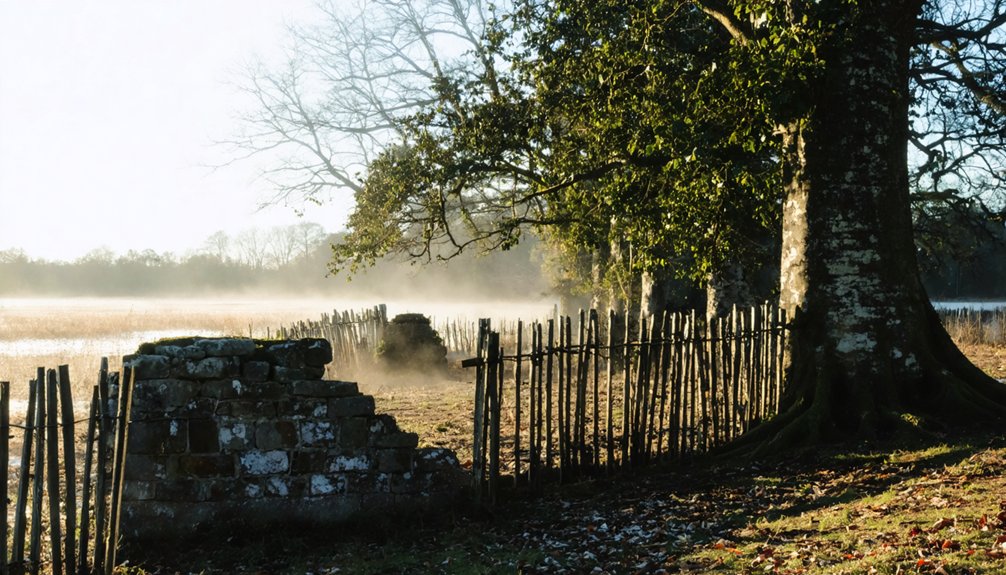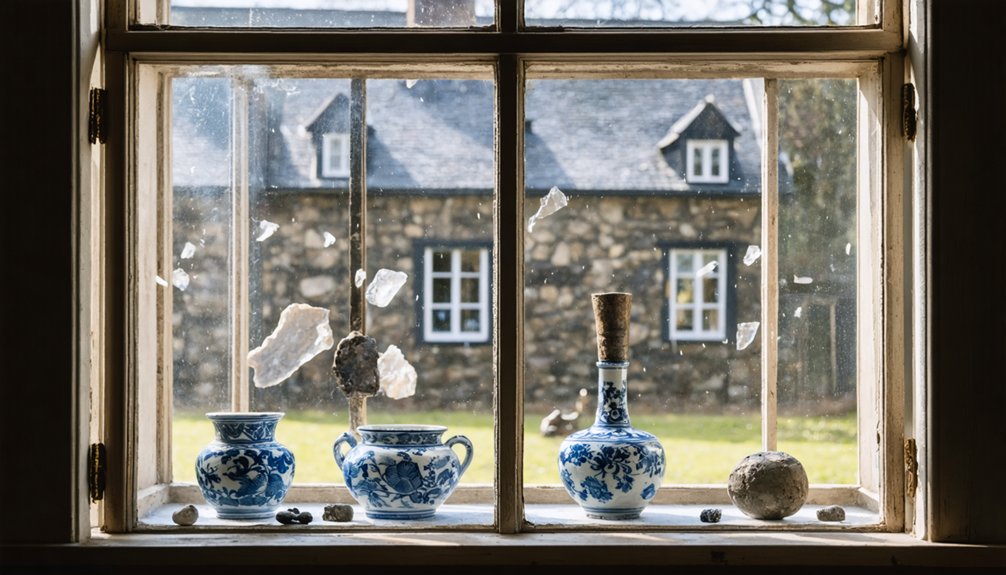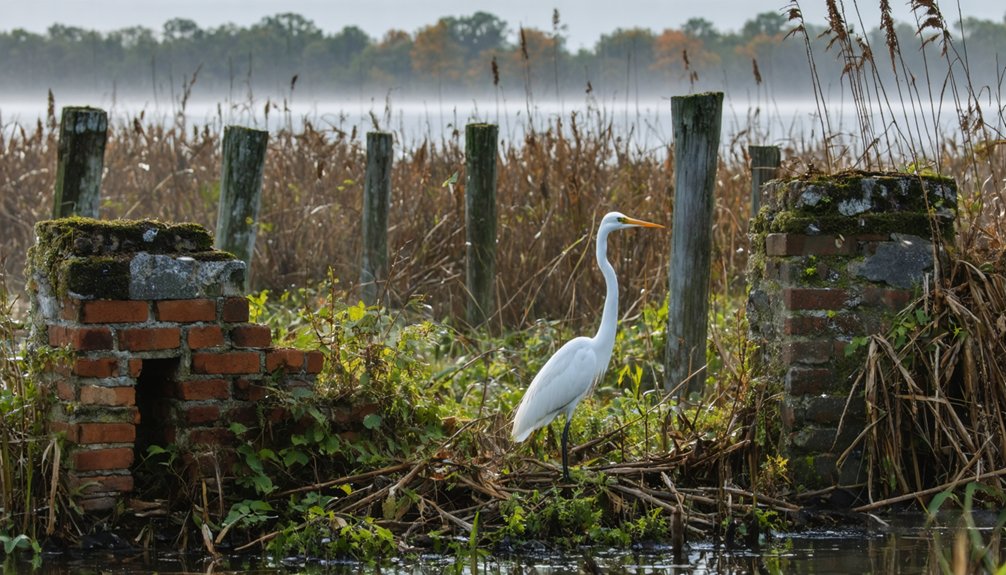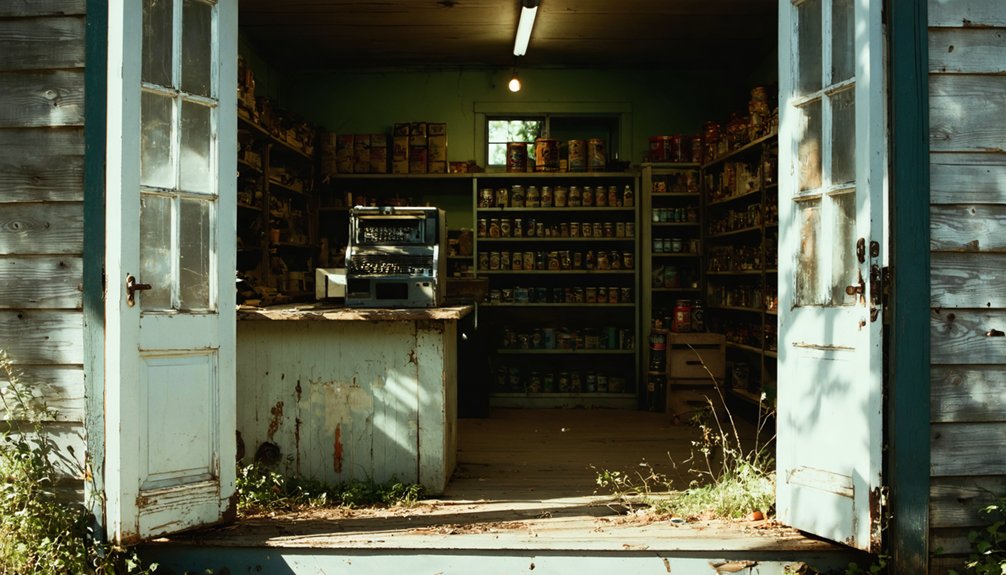You’ll find Zwaanendael, Delaware’s first European settlement, near present-day Lewes. Established in 1631 by the Dutch West India Company as a whaling and trading post, this fortified colony of 28-32 settlers met a tragic end within its first year. A cultural misunderstanding over a piece of tin led to a devastating Lenape attack, leaving only two survivors and transforming the site into one of America’s earliest ghost towns. The settlement’s brief existence shaped Delaware’s colonial identity in unexpected ways.
Key Takeaways
- Zwaanendael was Delaware’s first European settlement, established in 1631 by the Dutch West India Company near present-day Lewes.
- The settlement lasted only months before being destroyed in a conflict with Lenape Indians, leaving just two survivors.
- After the massacre, Zwaanendael’s ruins were abandoned and burned, effectively becoming Delaware’s first ghost town.
- The settlement’s original site included Fort Oplandt and housed 28-32 colonists involved in whaling and agriculture.
- Today, the Zwaanendael Museum preserves the settlement’s history through artifacts and educational programs about Delaware’s Dutch colonial heritage.
Origins of the Dutch Colony
In 1631, the Dutch West India Company established Zwaanendael, meaning “Valley of the Swans,” as a strategic whaling and trading post near present-day Lewes, Delaware. Under the direction of Samuel Blommaert and Samuel Godyn, this colony represented Dutch motivations to expand their influence along North America’s eastern seaboard.
You’ll find the settlement’s colonial aspirations were ambitious, featuring a palisaded fort complete with Holland’s red lion rampant on its gate. The Dutch appointed Gillis Hosset as governor and deployed the ship *The Walvis* for both transportation and defense. The settlement began with twenty-eight colonists who arrived to establish the new community. Their presence followed Henry Hudson’s exploration of Delaware Bay and River in 1609, which had sparked Dutch interest in the region.
Located near Cape Henlopen, Zwaanendael predated other European settlements in the region and showcased typical Dutch architectural influences, including a timber stockade for trading activities. The colony’s establishment marked the Dutch West India Company’s first attempt to gain a foothold in this resource-rich territory.
Purchase and Land Claims
Before establishing their settlement, the Dutch West India Company secured legal ownership of the land through a significant purchase in 1629. Samuel Blommaert and Samuel Godyn orchestrated this land acquisition, which extended from Cape Henlopen to the Delaware River’s mouth. Peter Minuit confirmed the purchase at Fort Amsterdam in 1630.
The territorial disputes began almost immediately. While you’ll find that the Dutch displayed Holland’s “red lion, rampant” on their fort gate to assert dominance, neighboring colonies, particularly Maryland, challenged their claims. A group of twenty-eight colonists arrived to establish the initial settlement. The Lenape Indians had already inhabited this region for generations before European arrival.
The purchased territory included a settlement on Lewes Creek and additional land near Cape May. Despite the Dutch West India Company’s legal framework and administrative support, conflicts with the local Cinconicins tribe and resource competition ultimately contributed to the colony’s downfall.
Life in Swan Valley
Life at Zwaanendael centered around a fortified settlement where 28-32 colonists balanced their duties between whaling, agriculture, and defense.
You’d find the daily routines strictly organized under Dutch West India Company leadership, with colonists dividing their time between working the fields and hunting whales off Delaware’s coast. The ship *The Walvis*, equipped with eighteen guns, supported both whaling ventures and colony protection. Led by David Pietersen de Vries, the settlers worked to establish a permanent Dutch presence in the region.
Community dynamics revolved around shared living spaces within Fort Oplandt’s wooden walls, marked by the red lion symbol of Holland. The settlement’s fate turned tragic when Lenape Indians wiped out the entire colony over a seemingly minor offense.
Behind Fort Oplandt’s wooden walls, marked with Holland’s red lion, colonists forged bonds through communal living and shared spaces.
You’d see tight-knit social bonds form as colonists worked together for survival, engaging in essential farming when not whaling. The small population meant everyone had multiple responsibilities, creating an interdependent community where Dutch cultural practices and occupational duties shaped daily life.
The Settlement’s Tragic End
You’ll find that Zwaanendael’s demise began with a cultural misunderstanding over a piece of tin bearing Dutch symbols, which the Native Americans’ chief took and displayed.
When the tribe tried to make amends by killing their own chief, his friends sought revenge through a devastating surprise attack on the settlers, who were working outside the fort.
The 1631 massacre left only two survivors – Pierre and Hendrick Wiltsee – while the rest of the settlement was burned to the ground, effectively ending the Dutch colony’s existence in the Delaware Bay area. The area would later become known as Hoeren-kil by 1642. Nearly four decades later, Marylanders under Thomas Howell’s command destroyed another Dutch settlement in the region on Christmas Eve.
Colonial Massacre Details
The tragic end of Zwaanendael unfolded in 1632 when a band of Lenape warriors attacked and killed all 32 Dutch colonists while they worked outside Fort Oplandt.
The massacre’s motivations stemmed from a series of misunderstandings over Dutch sovereignty, beginning when colonists erected a post bearing Holland’s arms on Lenape land.
Colonial tensions escalated after Commissary Gillis Hossett complained about an alleged insult to Dutch authority. When local Lenape tried to make amends by bringing the head of a supposed offender, the situation only worsened.
This devastating attack left the fortjen and house completely burned, as later confirmed by David Pietersz de Vries upon his return to the settlement.
Native Relations Gone Wrong
Events leading to Zwaanendael’s tragic end began well before the 1632 massacre, rooted in cultural misunderstandings between Dutch settlers and Lenape tribes.
You’ll find that the Dutch’s decision to erect a post with their coat of arms on a metal plate proved fateful, as the indigenous peoples likely viewed this as a territorial affront.
When a Native member removed the plate, possibly to craft pipes, it triggered a chain of diplomatic missteps.
The Lenape’s attempt at indigenous diplomacy – presenting the alleged offender’s head to Dutch leaders – failed to bridge the widening cultural divide.
The peace-loving nature of the Lenape made the violent turn of events particularly tragic for both sides.
With tensions already high from ongoing conflicts with neighboring Susquehannocks, and the Dutch focused on short-term trade gains rather than lasting relationships, the settlement’s destruction became inevitable through escalating retaliatory violence.
Historical Impact on Delaware

Although brief in existence, Zwaanendael’s establishment in 1631 fundamentally shaped Delaware’s territorial development and colonial identity.
You’ll find its influence in the state’s earliest land deed, which defined much of Delaware’s modern boundaries through the Dutch purchase from Indigenous peoples. This pioneering settlement laid groundwork for cultural exchange and trade networks that subsequent European powers would build upon.
When you examine Delaware’s historical narratives, you’ll see how Zwaanendael’s legacy endures through shifting colonial controls – from Dutch to Swedish to English rule.
The settlement’s impact resonates in present-day Lewes, where museums preserve this foundational chapter of Delaware history. While the colony lasted only months, it established patterns of European-Indigenous relations and territorial claims that would influence Delaware’s development for generations.
Dutch Legacy and Modern Commemoration
You’ll find evidence of Dutch colonial architecture preserved in the Zwaanendael Museum, which was modeled after the town hall in Hoorn, Netherlands, to honor the region’s earliest European settlers.
The museum’s distinctive design reflects the Dutch West India Company‘s architectural influence during their brief but significant presence in colonial Delaware.
The site’s maritime trading post legacy remains visible through artifacts and exhibits that showcase how the Dutch established commercial networks along the Delaware coast, despite the settlement’s tragic end.
Dutch Colonial Architecture Preserved
Standing as a tribute to Delaware’s Dutch heritage, the Zwaanendael Museum in Lewes showcases authentic Dutch Colonial architecture through its meticulous replication of Hoorn’s 17th-century town hall.
You’ll find distinctive architectural elements that define its Dutch Renaissance style, including an impressive stepped gable roofline, intricate spiral stone carvings, and decorative shutters. Architect E. William Martin captured these authentic details after studying the original building in Hoorn.
The museum’s design features symbolic elements that reinforce its cultural significance, including a rooftop statue of David Pieterszoon de Vries, the colony’s founder, alongside a unicorn representing Dutch heraldry.
As a well-preserved example of Dutch Colonial architecture, the museum continues to serve as both a cultural monument and a living representation to Delaware’s earliest European settlement.
Maritime Trading Post Influence
Beyond its architectural legacy, the Zwaanendael settlement established Delaware’s maritime foundation as a Dutch whaling and commercial post in 1631.
You’ll find evidence of this early maritime commerce through the Dutch West India Company’s strategic investment in the ship *The Walvis*, which protected waters while supporting whaling operations to offset colonial costs.
Though the original settlement was short-lived, Dutch influence shaped the region’s lasting maritime identity.
The natural harbor at Lewes evolved into a significant refuge for ships, while whaling traditions set by early Dutch settlers continued through Swedish and English colonial periods.
Today, you can explore this rich heritage at the Zwaanendael Museum, where shipwreck artifacts and seafaring folklore tell the story of Delaware’s maritime origins and 400-year evolution as a coastal trading hub.
Archaeological Findings and Museum Preservation

Archaeological investigations of Zwaanendael have revealed a rich tapestry of colonial and Native American history, with findings spanning from the 1631 Dutch settlement to maritime artifacts from the 18th century.
You’ll find evidence of cultural misunderstandings between European settlers and the Cinconicins, which ultimately led to the settlement’s destruction.
Today, you can explore these archaeological artifacts at the Zwaanendael Museum, modeled after Hoorn’s town hall in the Netherlands.
Visit the distinctive Zwaanendael Museum, where Dutch colonial architecture houses local archaeological treasures in historic Lewes, Delaware.
The museum’s crown jewel is the DeBraak exhibit, featuring remnants from the 1798 British warship wreck.
The museum’s cultural preservation efforts extend beyond maritime history, showcasing everything from segregated beaches to local folklore.
Through state support and archaeological collaboration, they’re maintaining these precious historical resources while offering free admission and educational programs to keep Delaware’s colonial history alive.
Frequently Asked Questions
What Crops Did the Dutch Colonists Attempt to Grow at Zwaanendael?
You’ll find the Dutch tried their hand at crop varieties like corn, beans, squash, and possibly tobacco, using agricultural techniques learned from Lenape natives during their brief settlement.
How Did the Colonists Communicate With Their Families Back in Amsterdam?
You’d communicate through letter writing carried by Dutch West India Company ships, though delays were common. Messages could take months to reach Amsterdam, making regular communication methods unreliable.
What Were the Daily Religious Practices of the Zwaanendael Settlers?
Like clockwork, you’d find settlers conducting daily prayers at dawn and dusk, while gathering for religious rituals on Sundays in shared spaces. You’d participate in Bible readings and psalm singing.
Which Native American Tribes Originally Inhabited the Area Before Dutch Settlement?
You’ll find the Cinconicins (Great Siconese) were the primary inhabitants, while Lenni Lenape and Nanticoke tribes moved through seasonally but didn’t permanently settle the specific Zwaanendael area before Dutch arrival.
What Weapons and Tools Did the Colonists Bring From the Netherlands?
You’ll find Dutch colonists brought muskets, cannons, and swords for defense, plus essential maritime tools like compasses and charts, alongside farming equipment including plows, axes, and fishing gear.
References
- https://kids.kiddle.co/Zwaanendael_Colony
- https://en.wikipedia.org/wiki/Zwaanendael_Colony
- https://www.britannica.com/place/Delaware-state/The-colony
- https://visitcentraldelaware.com/blog/the-history-of-delaware-and-william-penn-2/
- https://www.historiclewes.org/timeline/
- https://abc7news.com/videoClip/15784039/
- https://kidskonnect.com/social-studies/zwaanendael-colony/
- https://www.newnetherlandinstitute.org/history-and-heritage/digital-exhibitions/a-tour-of-new-netherland/delaware/swaanendael
- https://history.delaware.gov/zwaanendael-museum/
- https://history.delaware.gov/zwaanendael-museum/zm_history/



